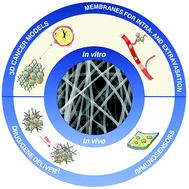当前位置:
X-MOL 学术
›
Biomater. Sci.
›
论文详情
Our official English website, www.x-mol.net, welcomes your feedback! (Note: you will need to create a separate account there.)
Electrospun nanofibers in cancer research: from engineering of in vitro 3D cancer models to therapy.
Biomaterials Science ( IF 6.6 ) Pub Date : 2020-08-24 , DOI: 10.1039/d0bm00390e Marta Cavo 1 , Francesca Serio , Narendra R Kale , Eliana D'Amone , Giuseppe Gigli , Loretta L Del Mercato
Biomaterials Science ( IF 6.6 ) Pub Date : 2020-08-24 , DOI: 10.1039/d0bm00390e Marta Cavo 1 , Francesca Serio , Narendra R Kale , Eliana D'Amone , Giuseppe Gigli , Loretta L Del Mercato
Affiliation

|
Electrospinning is historically related to tissue engineering due to its ability to produce nano-/microscale fibrous materials with mechanical and functional properties that are extremely similar to those of the extracellular matrix of living tissues. The general interest in electrospun fibrous matrices has recently expanded to cancer research both as scaffolds for in vitro cancer modelling and as patches for in vivo therapeutic delivery. In this review, we examine electrospinning by providing a brief description of the process and overview of most materials used in this process, discussing the effect of changing the process parameters on fiber conformations and assemblies. Then, we describe two different applications of electrospinning in service of cancer research: firstly, as three-dimensional (3D) fibrous materials for generating in vitro pre-clinical cancer models; and secondly, as patches encapsulating anticancer agents for in vivo delivery.
中文翻译:

癌症研究中的电纺纳米纤维:从体外3D癌症模型的设计到治疗。
从历史上讲,静电纺丝与组织工程有关,因为静电纺丝具有生产纳米/微米级纤维材料的能力,这些材料的机械和功能特性与活组织的细胞外基质极为相似。最近,对静电纺丝纤维基质的普遍兴趣已扩展到癌症研究,既可以用作体外癌症建模的支架,也可以用作体内的贴剂。治疗性递送。在这篇综述中,我们通过对过程进行简要描述并概述该过程中使用的大多数材料来检查静电纺丝,并讨论改变过程参数对纤维构象和组件的影响。然后,我们描述了静电纺丝在癌症研究中的两种不同应用:首先,作为用于生成体外临床前癌症模型的三维(3D)纤维材料。第二,作为包封用于体内递送的抗癌剂的贴剂。
更新日期:2020-09-15
中文翻译:

癌症研究中的电纺纳米纤维:从体外3D癌症模型的设计到治疗。
从历史上讲,静电纺丝与组织工程有关,因为静电纺丝具有生产纳米/微米级纤维材料的能力,这些材料的机械和功能特性与活组织的细胞外基质极为相似。最近,对静电纺丝纤维基质的普遍兴趣已扩展到癌症研究,既可以用作体外癌症建模的支架,也可以用作体内的贴剂。治疗性递送。在这篇综述中,我们通过对过程进行简要描述并概述该过程中使用的大多数材料来检查静电纺丝,并讨论改变过程参数对纤维构象和组件的影响。然后,我们描述了静电纺丝在癌症研究中的两种不同应用:首先,作为用于生成体外临床前癌症模型的三维(3D)纤维材料。第二,作为包封用于体内递送的抗癌剂的贴剂。


























 京公网安备 11010802027423号
京公网安备 11010802027423号